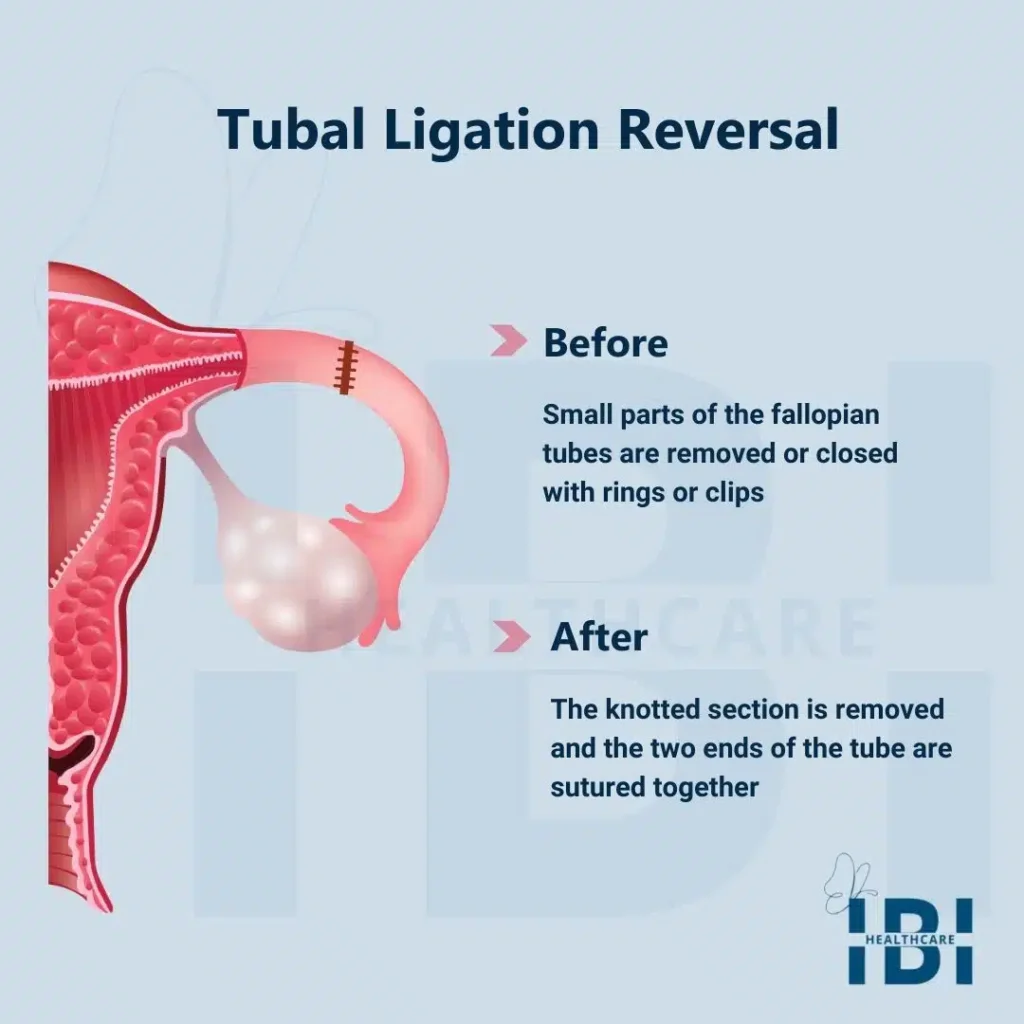Tubal Ligation Reversal
What is a Tubal Ligation Reversal?
Tubal ligation reversal restores fertility by reconnecting blocked or cut fallopian tubes. Many women choose tubal ligation to prevent pregnancy. However, life circumstances may change, leading some to reconsider.
Women who had tubal ligation may seek a reversal to conceive again. Surgeons reconnect the blocked or cut fallopian tubes. If successful, the egg moves through the tube, allowing sperm to reach it for fertilization.
Who is a Good Candidate for the Procedure?
Ideal candidates for tubal ligation reversal are women between 20 and 45 years old in good health with a reversible type of ligation and a strong desire for pregnancy. Supportive partners and realistic expectations are also important.
How does Tubal Reversal Surgery Work?

Once under general anesthesia, the surgeon begins the reversal surgery.
The procedure usually takes between two and three hours.
A small camera helps assess the fallopian tubes to determine if reconnection is possible.
The surgeon inserts the camera through a tiny incision in the navel. If conditions allow, a small bikini-line incision follows.
Delicate stitches reconnect the fallopian tubes through the lower incision.
Most patients recover at home the same day.
After surgery, the surgeon provides care instructions and pain medication.
Normal activities typically resume within two weeks.
Tubal Ligation Reversal Benefits
Also known as tubal reanastomosis, tubal ligation reversal, is a surgical procedure that can restore fertility in women who have previously undergone tubal ligation. The benefits of tubal ligation reversal include the possibility of conceiving naturally, without the need for assisted reproductive technologies such as in vitro fertilization. This can be particularly appealing for women who desire to have more children or who regret their decision to undergo tubal ligation. Additionally, tubal ligation reversal may also provide a sense of emotional and psychological relief for women who have experienced regret or sadness over their inability to conceive after undergoing tubal ligation. Overall, the procedure offers women the opportunity to regain their fertility and expand their family if they so desire.
Can You Reverse All Tubal Ligations?
It is not possible to undo all tubal ligations. In some situations the method used to block the fallopian tubes causes too much damage making reversal impossible. Surgeons have a better chance if the initial surgery used clips or rings or if only a small portion was removed. Selecting an experienced skilled doctor is crucial for a successful outcome.
What is the Success Rate of Tubal Ligation Reversal?
The success rate typically ranges from 45% to 85% depending on factors including:
- The surgeon’s expertise.
- Patient’s age and health, tubal ligation method, fallopian tube condition, and tube length.
- At least 3 inches of functional tube is ideal. A fertility specialist can assess individual chances based on these factors.
How much does Tubal Ligation Reversal Surgery Cost?
Many things affect the cost including the location, type of reversal, and pre-surgery tests. In the U.S., tubal reversal costs between $5,000 and $21,000, averaging $8,685. Health insurance usually does not cover it but financing plans are available. Doctor will discuss cost details during the first consultation.
Frequently Asked Questions
How successful is a tubal ligation reversal?
The success rate of tubal ligation reversal is influenced by various factors, including the patient’s age, general health, and the specific method of tubal ligation that was used. Additionally, the expertise of the surgeon is a significant factor in the outcome.
On average, the success rate for achieving pregnancy after tubal ligation reversal ranges from 70% to 80%. Some studies even report higher success rates.
However, other factors can affect these rates. The presence of scar tissue or complications from the original procedure may lower success chances. Always consult a qualified fertility specialist to discuss your individual chances based on your specific circumstances.
What are the reasons behind the inability to reverse a tubal ligation?
Reversing a tubal ligation can be difficult for several reasons.
First, the original procedure may have damaged the fallopian tubes. Scar tissue from surgery can complicate reconnection. The length and quality of the remaining tubes also affect success. Individual factors like age, health, and fertility status further influence the reversal outcome.
Is there an age limit for tubal reversal?
No specific age limit exists for tubal reversal. Eligibility depends on various factors, including overall health and medical history. Women should be in good health when considering tubal reversal. They must also have realistic expectations about the procedure’s outcomes. Consulting a qualified healthcare provider is crucial. This consultation helps determine if tubal reversal suits individual health and history.
Can tubes naturally become untied?
Tubes can become untied naturally if they are not securely fastened or if there is excessive movement or pressure applied to them. Additionally, environmental factors such as heat or moisture can weaken the material of the tube, making it more prone to coming untied. It is important to regularly check and secure tubes to prevent them from becoming untied and causing potential hazards or disruptions.
What is the level of discomfort associated with a tubal reversal?
The level of discomfort associated with a tubal reversal can vary from person to person. Some women may experience mild discomfort and cramping after the procedure, while others may have more significant pain. The discomfort is usually manageable with over-the-counter pain medication and typically resolves within a few days. It’s important to follow the post-operative care instructions provided by the surgeon to help minimize discomfort and promote healing. Overall, while some discomfort is to be expected, many women find that the benefits of having a tubal reversal outweigh the temporary discomfort.
Which is more cost-effective, tubal reversal or IVF?
The cost-effectiveness of tubal reversal versus IVF depends on various factors such as the age of the woman, the success rates of each procedure, and individual health factors. Tubal reversal may be more cost-effective for younger women with healthy fallopian tubes, as it allows for natural conception and multiple attempts at pregnancy. On the other hand, IVF may be more cost-effective for women with other fertility issues or older women, as it offers a higher success rate per cycle and can be combined with other fertility treatments. Ultimately, the decision between tubal reversal and IVF should be made in consultation with a fertility specialist, taking into account individual circumstances and preferences.
Is it possible to untie tubes and conceive again?
Yes, it is possible to untie tubes and conceive again through a surgical procedure called tubal ligation reversal. During this procedure, the blocked or tied tubes are reconnected to allow for the possibility of natural conception. However, the success of this procedure can vary depending on factors such as the original method of tubal ligation, the length and condition of the remaining fallopian tubes, and the age and fertility of the individual. It is important to consult with a fertility specialist to discuss the potential risks and success rates of tubal ligation reversal before considering this option.
If you are ready to explore your options for restoring your fertility through tubal ligation reversal, don’t hesitate any longer. Schedule a consultation with our specialists today. They will guide you through every step of the process.
